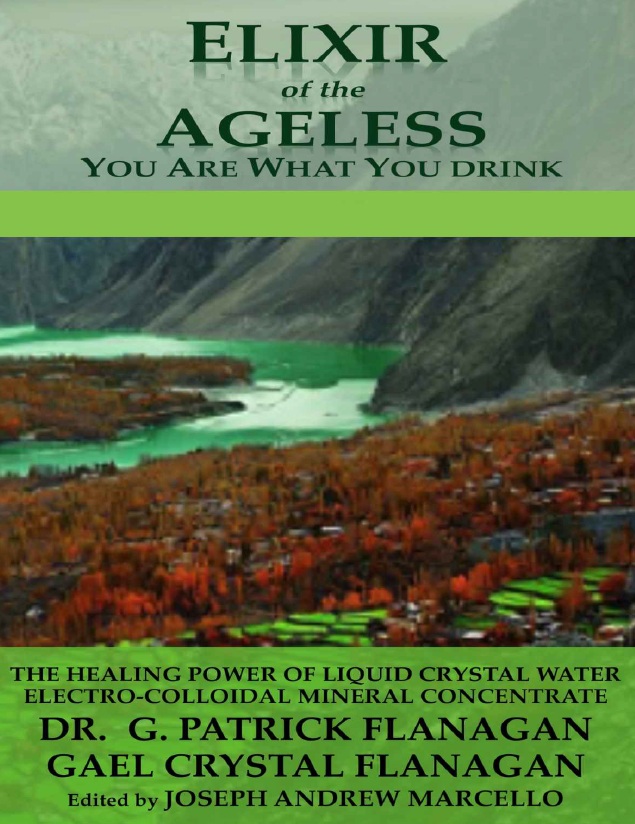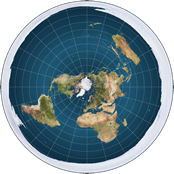
Patrick Flanagan - Gael Flanagan
Elixir of the ageless : You are what you drink
The healing power of liquid crystal water electro-colloiadal mineral concentrate
High in the mountains of northern India, in the foothills of the Hindu Kush lies the legendary Shangri La. The movie Lost Horizon was filmed in the area of the small country known as Hunza.
In the film, Shangri La was a high altitude hidden valley surrounded by jagged mountain peaks.
The people of Shangri La lived in an age-less condition as long as they stayed in their valley which had the power to bestow eternal youth upon those who lived there.
Although Shangri La is just a legend, most legends have some basis in fact. In the rugged land of Hunza, people have lifespans of up to 130 years and enjoy excellent health free of the diseases that ravage modern man. In fact, many of these people have children after the age of 100 !
The trek to Hunzaland is treacherous. As the traveler leaves Shrinagar he climbs high into the Karakorum mountains using narrow trails that cling perilously to rocky slopes. He crosses hanging rope bridges that span chasms dropping 3,000 feet to icy rivers.
Eventually he reaches the 8,000 foot mountain valley which is Hunzaland. This hidden valley is surrounded by over 100 mountains that rise above 20,000 feet.
These mountain peaks with blue glaciers are millions of years old. In the distance he can see the peak of Nanga Parbat the third highest mountain in the world.
Through decades, dozens of scientists and health investigators have made the trek to Hunza in an effort to unlock the secrets of long life and eternal youth.
Most investigators have studied the Hunza diet, (believing the secret of long life was in what these people ate.) While diet is extremely important, the first Hunza secret is not in what they eat, but in what they drink. They believe their water is an elixir of long life.
The Mir or King of Hunza told health researcher Betty Lee Morales: "Our good health and long life is in our water. It comes from the glaciers and carries with it special minerals that revitalize our cells.”
Throughout history hundreds of explorers have traveled the world in search of a legendary 'Fountain of Youth.’ Could it be that this fountain lies in the remote region of Hunza ? Actually, there are at least five areas on Earth where people live to be in excess of 100. These areas have one thing in common--the people of these places claim that the special cloudy minerals in their water keep them young and healthy.
In all cases, the water is cloudy, and comes from ice blue glaciers. Glacier water has no minerals and is nearly identical in composition to distilled water. In springtime, as the glacier melts, water travels through special mineral beds and absorbs high energy colloidal minerals in its journey.
In the early 1930’s, Dr. Henri Coanda, a Rumanian Scientist who is known in our time as the 'Father of Fluid Dynamics' made the arduous journey to Hunza.
Coanda also traveled to the five other remote areas on Earth where people live to be over 100 and remain in perfect health.
The areas Dr. Coanda had visited included the county of Georgia high in the mountains of Russia, a remote community in outer Mongolia, the Vilcabamba mountain valley in Ecuador, and a hidden valley in Peru. In each of these places the natives attribute their health and long life to their precious cloudy colloidal mineral water.
As a result of these investigations Dr. Coanda came to the conclusion that the old saying: "We are what we eat” should be changed to "We are what we drink.” Coanda spent most of his long life in search of the secret of Hunza water. When he died he was the president of the Rumanian Academy of Sciences.
In the early 1960's, Dr. Coanda was hired as a consultant by Huyck Research Laboratories in Stamford, Connecticut. Huyck Corporation, had developed a think tank that was involved in far reaching research into unusual scientific phenomena.
Huyck labs was investigating two major research projects at the time, the Coanda Effect and an electronic hearing device of my invention which was known as the Neurophone. I was 18 years old and Dr. Coanda was nearing 75.
The Coanda Effect is the phenomenon of fluid flow that enables airplanes to fly. Simply stated, when a fluid flows over a surface it tends to cling to that surface.
If the surface curves the fluid will follow the curve and will also entrain or capture outside fluid along with it. If the curve and the fluid flow are in resonance with each other, the device will act as a fluid amplifier, that is it will increase flow volume and/or acceleration.
This discovery led to the development of fluid computers, fluid amplifiers and a variety of other inventions to make life easier.
One of his Coanda Effect inventions produces such a rapid change in fluid flow and pressure that it reduces the temperature of air flowing over the surfaces. This change is so great that if water is injected into the air fIow it produces ice crystals and perfect snowflakes. This device is called a Coanda Nozzle.
ln the 1930's he used the device to make the first artificial snow for the ski slopes of France.
While at Huyck Labs, Coanda was assisting in the development of a number of devices that utilized the Coanda Effect. These included a torpedo that could travel through water at 100 miles per hour without creating a wake.
On Coanda's 75th birthday a party was thrown in his honor at the New Canaan home of G. Harry Stine, Director of Research at the laboratory. As I was 18 years old, I wanted to say something complimentary to Coanda.
So I told him that I hoped that I would be in as good health as he was when I was 75 years old. Coanda looked me in the eye and said, "When you are 75 Years old, Patrick, we will talk about it.”
As Coanda and I were both inventors and consultants at Huyck we became good friends. One day Dr. Coanda asked me to come into his office for a visit. He told me he wanted to tell me something of great importance.
He said he wanted to share the results of his lifelong search for the Fountain of Youth. Since he would probably not complete his research, he thought I might discover the answer since I had my entire life ahead of me.
He told me about his world travels during which he had examined the precious glacier waters of Hunza, the county Georgia in Russia, the high mountain valleys of Mongolia and the Andes and Peru, but he had not deciphered the secret of these waters.
He explained that the secret of lot was somehow related to the molecular structure of water. He was able to test waters in these places by turning samples into snowflakes by using his snowmaking fluid amplifier.
He said that snowflakes are living forms with a circulatory system composed of tiny tubes in the center of the snowflake structure. These tubes are an analog of the circulatory systems in animals and plants. They are tiny veins that circulate water that is not yet frozen.
This water is anomalous water, that is, the venous liquid crystal water of the snowflake does not freeze at zero Celsius like ordinary water. It freezes much more slowly. When the water in these veins does eventually freeze the snowflake is dead.
By timing the life of the snowflake he was able to establish a direct relationhip to the human lifespan in the area where the water was tested. He said this anomalous water was the key to the long life of the Hunza people.
He said that he believed I would someday discover the secret of the cause of this anomaly and as a result I would be able to give the benefits of Hunza water to people all over world. That was in 1963; shortly after that I went back to my home in Bellaire, Texas and Dr. Henri Coanda went to Rumania where he became the president of the Rumanian Academy of Sciences.
Patrick Flanagan - PDF
Water - PDF



